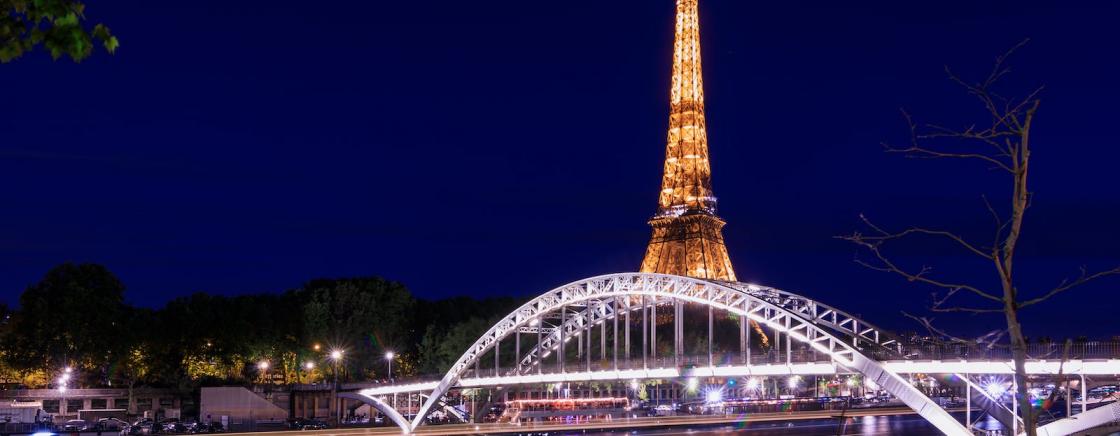
Are you a fan of long walks or bike rides? If you like to lose yourself in the streets and stumble across a monument in Paris of unparalleled beauty, you'll love the Passerelle Debilly.
Between the Pont de l'Alma and the Pont de Liéna, this pedestrian and cycle bridge links the 16th and 7th arrondissements, just a stone's throw from the famous Eiffel Tower. Its impressive, elegant structure has won over many Parisians and tourists alike. In the city of Paris, this footbridge is a historical and architectural treasure, making a lasting impression on visitors.
Its history
The debilly footbridge, 120 meters long and 8 meters wide, was built for the 1900 Paris Universal Exhibition. This event was undoubtedly the largest exhibition in France, and the first of which there are cinematographic remains. It attracted an exceptional number of tourists, 50.8 million in all. These millions of visitors came to discover new innovations in art, science and technology. Today, some of the legacies and attractions of this 1900 exhibition remain, such as the appearance of the first metro line, opened for the occasion, and the Petit and Grand Palais. It was during one of these exhibitions that Paris also welcomed the famous Eiffel Tower. On April 1966, the Debilly footbridge was even listed as a historic monument.
A little historical anecdote: during the notorious Cold War, this place was a central meeting point and secret meeting place for the special services of the East, so much so that a few days after the fall of the Berlin Wall, the body of a former GDR agent was found in the Seine, not far from the footbridge.
Designed by the architect Résal and the engineer Daydé, this footbridge was created and inaugurated for the duration of the exhibition, to facilitate access from the Quai de New York on the right bank of the Seine to the esplanade des Invalides on the left bank. Due to its immense popularity, this was retained and has become a permanent feature of the Parisian landscape.
The footbridge is named after General Jean-Louis-Charles Alphonse Debilly, who fought alongside Napoleon Bonaparte. The bridge bearing his name is a tribute to his service and commitment in battle, but also a historic link between France's past and present, a means of commemoration. But before it was given its current name, the footbridge was known as the "military exhibition footbridge".
Innovative architecture
The structure of the Debilly footbridge is rich and complex. In fact, if you look closely, you'll see a combination of shapes, floral motifs and wrought-iron ornamentation, creating a bridge that's as harmonious as it is innovative, blending seamlessly with its natural surroundings.
As well as being a functional structure, it is also an important and impressive design element. What's most notable about this structure is its large central arch, often described as a work of art in its own right. Richly decorated, its floral ornaments are reminiscent of garlands of flowers. The extremities of this monument are equally elaborate and admirable, with absolutely breathtaking wrought-iron work.
An ideal location
As well as being innovative and aesthetically pleasing, the location of this footbridge is ideal. At the center of the bridge, you'll be able to observe the Seine, equidistant between the two banks, and admire the splendor of the spectacular Eiffel Tower. Indeed, the panorama offered by this footbridge allows you to observe the Iron Lady and the sumptuous Trocadero gardens, day and night, enjoying a unique view of Paris in a very romantic setting and atmosphere.
The footbridge is also close to many other monuments in Paris, such as the Musée du Quai de Branly and Les Invalides.

On your screens...
Now an unusual landmark in Paris, the footbridge can be seen in many films.
In 1999, Vanessa Paradis played the character of Adèle in the film "The Girl on the Bridge". We see her in the very first scene on the Debilly footbridge, a scene of great importance as it sets the tone for the film.
In 2002, the bridge was used as a meeting place for the protagonist of Brian de Palma's film "Femme Fatale".
Numerous artists have also made the site their own, filming video clips such as Jenifer's "l'amour fou" or Yseult's "corps".
A meeting place for culture
As well as welcoming you for pleasant, romantic strolls, this footbridge also organizes numerous cultural events.
A few times a year, the footbridge is transformed into an open-air exhibition site, allowing local and international artists exhibit their work in an incredible setting between the Seine and the Eiffel Tower.
For a more festive atmosphere, musical events are regularly scheduled, especially during the summer season. Discover local bands for open-air performances.
In a sporting mood, this footbridge is the starting and finishing point for many races and other sporting events, a very pleasant place to enjoy the unique panoramic view during your race.
A rich and fascinating history, an ideal location, an impressive view and an important cultural site, this footbridge is an absolutely unavoidable monument on your visit to Paris.